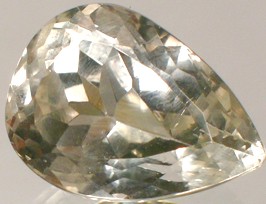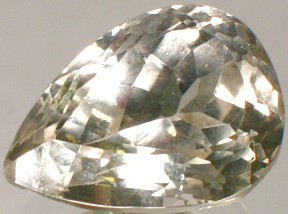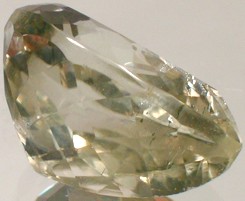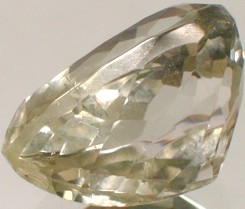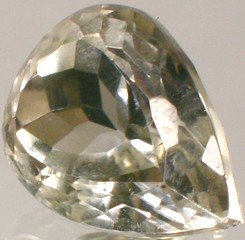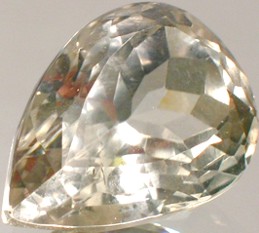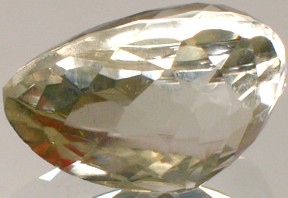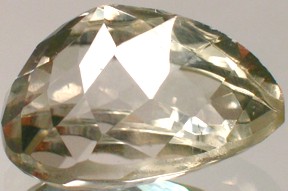|
For Customers outside of USA 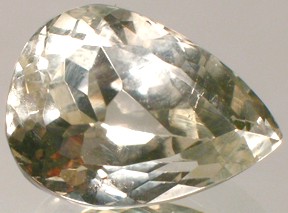
Antique Genuine Natural Russian/Afghani Five Carat Faceted Yellow Kunzite Semi-Precious Gemstone.. CLASSIFICATION: Faceted Yellow Kunzite. ORIGIN: Afghanistan. 19th Century. SIZE: Length: 12mm. Width: 9mm. Depth: 6 1/2mm. All measurements approximate. WEIGHT: 5.04 carats. NOTES: Upon request we can set your gemstone as a ring, earring, or pendant.
DETAIL: Well known to Indian and Russian jewelers of the eighteenth and nineteenth century, but "newly discovered" in America in the twentieth century, kunzite, especially violet to pink shades of kunzite have become enormously popular in the first decade of the twenty-first century. Originally referred to as "pink amethyst" in Central Asia and Eastern Europe, it is a rare and gorgeous gemstone which typically can shift colors between pink-violet, and (depending on how it is cut) on occasion, yellow or green (which is sometimes referred to as "hiddenite"). It is noted for its feminine and alluring hues which range between pastel pinks and violets to intense, almost "neon" hues. Depending on the cut, it can also possess incredible sparkle and brilliance. This particular specimen originated in Afghanistan, and was hand crafted and faceted by a 19th century Russian artisan, part of an heritage renown for the production of the elaborate gemstones and jewelry of the Czars of Medieval, Renaissance, and Victorian Russia. As you can see in these photo enlargements, the gemstone is absolutely eye clean. Even in these photo enlargements it is not easy to discern the minute blemishes that the gemstone possesses. It may be conservatively described as "eye clean", though it is not absolutely flawless (absolutely flawless gemstones are very rare in nature, they typically turn out to be synthetic "lab" gems).
Under magnification the gemstone shows the unmistakable characteristics of having been hand crafted. The coarseness of the 19th century finish is considered appealing to most gemstone collectors, and is not considered a detriment, or detract from the value of a gemstone. These characteristics are not only expected of hand-finished gemstones, most serious collectors consider such gemstones more desirable, possessed of greater character and uniqueness when compared to today's cookie-cutter mass-produced machine-faceted gemstones. Unlike today's computer controlled machine produced gemstones, the cut and finish of a gemstone such as this is the legacy of an artisan who lived two centuries ago. This gemstone has great luster and sparkle, and to the eye is completely transparent, but it is not absolutely flawless. True, the blemishes it possesses are virtually invisible to the naked eye, and the gemstone can be characterized, to use trade jargon, as "eye clean". However in these photo enlargements (or in a jeweler's loupe or scope) you might be able to discern a few minor blemishes within the stone. Of course the same may said about almost any natural gemstone. An absolutely flawless gemstone simply is not the rule in nature. Most absolutely flawless gemstones will upon close examination be revealed to be synthetic. You might also notice under magnification occasional irregularities in the cut and finish. Naturally these characteristics are not only expected of hand-finished gemstones, you must also consider that two centuries ago the mining techniques prevalent did not allow the ultra deep mining operations which are so common today.
Keep in mind two centuries ago mankind was more or less limited to surface deposits or near surface deposits of gemstones. Higher quality gemstones which today are routinely mined from beneath hundreds of meters, even kilometers beneath the earth's surface, were simply inaccessible then. For these reasons antique gemstones must be appreciated as antiques first, gemstones second. The relatively superlative quality of contemporary gemstones routinely mined from deep beneath the earth's surface today were simply not accessible two centuries ago, or at least, only rarely so. However for most, the unique nature and character of antique gemstones such as this more than makes up for miniscule blemishes and cutting imperfections which by and large, are only visible under high magnification.
HISTORY: Kunzite is an unusual and rare gemstone stone. It was known in Central Asia and in Eastern Europe as early as the sixteenth century from sources in Afghanistan and Russia. A variety of spodumene, it was believed by Russian jewlers to be a variety of pink amethyst. There are also references to it in ancient Hindu texts, where it was referenced as having been produced in what is present-day Pakistan. Kunzite was first "discovered" in America at the Pala Chief Mine near San Diego, California and named after Tiffany's chief gemologist George Frederick Kunz, who was the first to give a comprehensive (and published) description of the gemstone shortly after the turn of the twentieth century. Another variety "discovered" in America was named "hiddenite", after A. E. Hidden who was one of the original mine owners of the type location for this spodumene variety in North Carolina.
By whatever name, it is still best known to geologists as "spodumene", the name derived from the Greek spodumenos, which meant "burnt to ashes" in reference to spodumene's commonly occurring light gray color. Spodumene is a major source of lithium (which is what gives it its pink color - violet undertones created by traces of manganese), which has a great variety of uses including in the manufacture of lubricants, ceramics, batteries, welding supplies, experimental fuels and in anti-depressant drugs. Kunzite displays two unusual characteristics; "phosphorescence" where Kunzite, in this respect similar to diamonds, is observed to glow in a darkened room after it has been exposed to the sun's ultra-violet rays and "Pleochroism", showing two different colors when viewed from different directions.
Kunzite commonly shows violet, pink, yellow or green hues depending upon the orientation of the cut gemstone. Transparent spodumenes of pink to violet color (kunzite) and yellowish-green to medium deep green (hiddenite) are used as gemstones. Kunzite was traditionally worn as a talisman which was believed to bring good luck to the wearer. Its soft pastel colors also came to symbolize purity. New age shamans and metaphysical practitioners regard it as a symbol of new life, specifically pregnancy. It is also believe to help the wearer understand and interact better with others, to help heal "broken hearts", to relieve stress and anger, and to bring love, peace and harmony. Kunzite is believed to help strengthen the circulatory system, and to be helpful in the treatment of lung disorders.
SHIPPING OPTIONS: All purchases are backed by an unlimited guarantee of satisfaction and authenticity. If for any reason you are not entirely satisfied with your purchase, you may return it for a complete and immediate refund of your entire purchase price. Most of these antique gemstones were originally part of two collections, one originating in India principally composed of gemstones originally mined in India, Burma, Ceylon, and Siam, and then hand faceted in India. The addition of a second accumulation of antique gemstones originally mined in the Urals in the mid to late 19th century (including alexandrite) completed the collection. These gemstones as well were hand finished. The Urals have been one of the world's major sources of precious and semi-precious gemstones for many centuries. As well, additional specimens are occasionally acquired from other institutions and dealers in Eastern Europe and Asia. These antique gemstones are now in the United States and are available for immediate delivery. We ship inventory from the USA order fulfillment center near Seattle, Washington. Your purchase will ordinarily be shipping within 48 hours of payment. A certificate of authenticity is available upon request. We prefer your personal check or money order over any other form of payment - and we will ship immediately upon receipt of your check (no "holds"). We will accept PayPal payments. Please see our "ADDITIONAL TERMS OF SALE".
|
|---|
